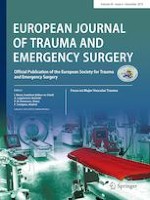Erschienen in:

19.06.2018 | Original Paper
The value of a standardized and reproducible surgical technique in treatment of Vancouver B2 periprosthetic fractures: our experience
verfasst von:
Stefano Biggi, Andrea Camera, Riccardo Tedino, Andrea Capuzzo, Stefano Tornago
Erschienen in:
European Journal of Trauma and Emergency Surgery
|
Ausgabe 6/2019
Einloggen, um Zugang zu erhalten
Abstract
Purpose
To retrospectively review results and complications of our standardized surgical technique addressed exclusively to Vancouver B2 fractures.
Methods
From January 2006 to July 2016, we treated 235 consecutive patients, 47 males and 188 females, mean age at surgery of 71 ± 10 years, with periprosthetic B2 fractures. Exclusion criteria were other kind of periprosthetic fractures and other femoral fractures. The patients were assessed clinically and radiographically following our standard protocol at the last available follow-up. The mean follow-up time was 6.4 years. Radiographic evaluation was performed according to Beals and Tower’s criteria and clinical evaluation was performed using the Harris Hip Score and clinical exam.
Results
From the starter cohort of 235, 207 patients (88.1%) were fully evaluated, while 28 were lost to follow-up. According to Beal and Tower’s criteria, we found excellent results in 72 patients (34.8%), good results in 133 patients (64.3%), and poor results in 2 patients (0.9%). Mean HHS was 75 ± 9 points, with a statistically significant correlation between good functional results and better radiographic assessment (p = 0.001). The use of support plate (p = 0.008) and the acetabular revision (p = 0.002) showed a statistically significant distribution with worse radiographic results. Late complications detected were ten dislocations.
Conclusion
Our experience suggests that using a standardized and reproducible surgical technique, as our technique proposed, can surely reduce surgical time, the complication rate, and the mortality rate. During acetabular evaluation, the choice of performing a cup revision must be weighed on overall patient’s assessment.











